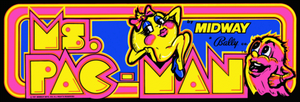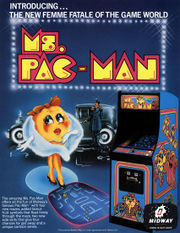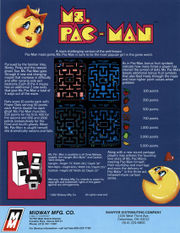Lost In Translation/Ms. Pac-Man
| Ms. Pac-Man | |
|---|---|
| Manufacturer | Midway |
| Released | 1981 |
| Control Method |
4-way Joystick 1 Button(s) |
| Main CPU | Z80 (@ 3.072 MHz) |
| Sound CPU | Mono Namco (@ 96.000 kHz) |
| Video Details |
Raster (Vertical) 288 x 224 pixels 60.61 Hz 512 Palette colours |
| Screens | 1 |
| ROM Info | 13 ROMs 35,616 bytes (34.78 KiB) |
| MAME ID | mspacman · mschamp · mspacmab · mspacmat · mspacmbe · mspacmnf · mspacpls · pacgal |
About The Game
Ms. Pac-Man is an arcade video game.
In this, the first proper sequel to Namco's legendary pill eating maze game, players must once again run around a number of mazes, eating all of the pills that are scattered throughout. The ever-present ghosts (Blinky, Pinky, Inky and Sue) return to hamper the player's progress. The infamous 'Power Pills' are also present and correct, with four appearing in each maze.
Namco introduced a number of changes and enhancements over the original game. The first difference is in the main character. For the first time in video-game history, the game's lead character was female. Ms. Pac-Man is almost identical to the original character with two main differences; she wears a bow in her 'hair', and is also wearing lipstick.
Another change from the original is that the bonus fruit items are no longer static but now move randomly around the mazes.
Level Overview
Ms Pac-Man features 4 different maze layouts, which alternate every 2 to 4 screens :
The 1st maze is only encountered in Rounds 1 and 2, and has 220 dots and 4 Power Pills. There are 2 sets of tunnels in this maze equidistant from the center of the maze. You must clear this maze 2 times before moving on to the next maze.
The 2nd maze is only encountered in Rounds 3, 4, and 5, and has 240 dots and 4 Power Pills. There are 2 sets of tunnels in this maze; one set in the lower half, and the other set at the very top. You must clear this maze 3 times before moving on to the next maze.
The 3rd maze is first encountered in Round 6 and has 238 dots and 4 Power Pills. Unlike all other mazes, there is only 1 set of tunnels in this maze, slightly above the center of the board. You must clear this maze 4 times before moving on to the next maze.
The 4rth and final unique maze is first encountered in Round 10 and has 234 dots and 4 Power Pills. There are 2 sets of tunnels in this maze, directly next to one another in the middle of the maze. The turns at the entrance to the tunnels change the usual immediate accessibility of the tunnels and should be taken in to account. You must clear this maze 4 times before moving on to the next maze.
After Round 13, the game alternates every 4 rounds between the third and fourth mazes.
Finally, the ghosts' movement patterns are also completely different to those of the original game.
Intermissions
As in the original game, intermission scenes will be played after certain rounds. Ms. Pac-Man's intermissions tell the story of how Pac-Man and Ms. Pac-Man met, fell in love, and had a baby. Ms. Pac-Man's intermissions are also preceded by a sign and a title. 3 intermissions are present :
Act I - They Meet
Pac-Man, the star of the original game, enters the screen being chased by Inky. Ms. Pac-Man enters from the other side being chased by Pinky. As the 2 of them are about to collide, they quickly move upwards, causing Inky and Pinky to collide. Pac-Man and Ms. Pac-Man face each other at the top of the screen, and a heart appears above them. This intermission is played after Round 2.
Act II - The Chase
Pac-Man and Ms. Pac-Man are seen giving each other a playful chase. One chases the other in one direction, and they take turns alternating who chases who and in what direction. After three turns, they chase each other twice more at a faster speed. This intermission is played after Round 5.
Act III - Junior
Pac-Man and Ms. Pac-Man anxiously await the arrival of a stork, who flies overhead with a bundle. As the stork is about to pass over them, he releases the bundle, which drops to the ground in front of Pac-Man and Ms. Pac-Man, and opens up to reveal a baby Pac. This intermission, which is played after Rounds 9, 13, and 17, would later serve as the introductory sequence to "Jr. Pac-Man".
No intermission is present between rounds after the 18th one.
Trivia
Having won their enhancement kit lawsuit against Atari, General Computing went to Bally Midway and showed them an enhancement kit that they were working on for Pac-Man called Crazy Otto. Crazy Otto was a character similar to Pac-Man with the exception that he had legs. GCC was going to bluff Midway into letting them release their enhancement kit by telling them that they won their lawsuit against Atari, and that they just wanted Midway's blessing. Midway suggested that they create a sequel to the original "Pac-Man" instead of an enhancement kit, and GCC got to work on Ms. Pac-Man. Ms. Pac-Man had two prior names before settling on the one that everyone knows. 'Mrs. Pac-Man' was the original, but some of the women employees at Midway had a problem with that, so it was changed to 'Miss Pac-Man'. When someone pointed out the third intermission, where Pac and Ms. Pac welcome "Jr. Pac-Man" (or Baby Pac-Man) into the fold, they changed it to the final name of 'Ms. Pac-Man'. Midway released "Baby Pac-Man" as a pinball/video hybrid, and General Computing sued the company, claiming they had created the concept of a Pac Family. They won the suit and were awarded royalties from Pac Family merchandise.
In its initial run 110,000 units were produced in the U.S. making it the best selling domestic arcade video game of all time.
The game added a few improvements over the original :
- Non-deterministic artificial intelligence for the ghosts, making it harder for enthusiasts to follow set patterns through levels.
- A variety of different mazes used through the game.
- Bonus items (such as cherries and pretzels) entered the maze and bounced through it, rather than appear in a set location as in the original, making the player go out of his way to attain it.
- Brand new sound effects, including a new 'death' sound and opening theme.
It was also one of the more successful of early arcade games in the female demographic, which has been attributed to 'Ms. Pac-Man' being a girl - although the Ms. Pac-Man sprite was little more than "Pac-Man" with eyelashes, a bow, lipstick and a dimple.
After the 255th level, the maze (including dots) disappears. The game becomes unplayable, since there are no more dots to eat.
Chris Ayra holds the record for this game on 'Regular' settings with 920,310 points on August 16, 1998.
Victor Kunisada holds the record for this game on 'Speed-Up' settings with 922,810 points on June 16, 2001.
Vancouver, Canada (Reuters) - Little seven year old, Al Nagac attained the Guinness World Record for Ms. Pac-Man v.2.97 with a score of 18,976,048. Al was exhausted and dehydrated and asked for several glasses of skim milk after shattering the longtime record of 11,056,736 set by Faith deRivera, who was onhand to congratulate the victor with a kiss on the cheek.
A Ms. Pac-Man unit appears in the 1983 movie 'WarGames', in the 1983 movie 'Joysticks', in the 1984 movie 'Tightrope' (the cab appears in the background of the bar scene), in the 1990 movie 'The Grifters' , in the 1999 movie 'Man on the Moon' and in the 2002 movie 'Van Wilder'.
Milton Bradley (MB) released a board game based on this video game in 1983. Up to 4 players can play. The maze is divided into four colored areas, representing each player; the object of the game is to clear all the dots in your colored area. Only one player at a time controls Ms. Pac-Man; the other players control the ghosts. Once a ghost catches Ms. Pac-Man, the player controlling that ghost takes over control of Ms. Pac-Man.
Some hacks are known as "Ms. Pac-Man Plus", "Ms. Pac Attack", "Ms. Pac-Man Champion Edition" and "Pac-Gal".
Scoring
| Item | Points |
|---|---|
| Dot | 10 |
| Power pill (energizer) | 50 |
| Ghosts | 200, 400, 800 & 1,600 |
| Cherry | 100 |
| Strawberry | 200 |
| Peach | 500 |
| Pretzel | 700 |
| Apple | 1,000 |
| Pear | 2,000 |
| Banana | 5,000 |
Tips and tricks
- The most dangerous section of the first maze is the long path at the very top. It is safest to clear it when the ghosts are blue, or at least 3 of them occupy the bottom half of the maze.
- There are a couple of dangerous sections in the second maze. The pathways above and below the T section at the top of the maze can be particularly easy to get trapped in. It is easiest to clear these when all 4 ghosts are close on your tail, or after eating one of the top two power pellets. The 2 sections directly above the lower escape tunnels on either side should also be cleared with caution.
- The most dangerous section of the 3rd maze is the center of the bottom, directly below where you begin. It is advisable to clear it out as early as possible before the ghosts can organize and trap you. The top section of the maze presents the ghosts with many pathways to reach you, so use caution.
- The most dangerous sections of the 4th maze is the section that you begin in, and the section directly above the ghosts' den. The very top section of the maze should also be cleared with caution.
- Secret Message : the message 'GENERAL COMPUTER CORPORATION Hello, Nakamura!' is buried at the end of the Ms. Pac-Man ROM image (Masaya Nakamura was head of Namco).
- There's a fairly well-known glitch in the game - if you put a coin in when the Ms. Pac-Man marquee title first appears but before Blinky appears then the first board will be blue instead of pink and will remain blue until you either finish the board or lose a life, after which the board will return to its normal color.
Series
- Puckman (1980)
- Ms. Pac-Man (1981)
- Super Pac-Man (1982)
- Pac-Man Plus (1982)
- Jr. Pac-Man (1983)
- Pac & Pal (1983)
- Pac-Land (1984)
- Pac-Mania (1987)
- Pac-In-Time (1994, Nintendo Super Famicom)
- Pac-Man 2 - The New Adventures (1994, Nintendo Super Famicom and Sega Mega Drive)
- Pac-Man VR (1996)
- Pac-Man World (1999, Sony PlayStation)
- Pac-Man - Adventures in Time (2000, PC CD-ROM)
- Ms. Pac-Man Maze Madness (2000, Sony PlayStation)
- Ms. Pac-Man - Quest for the Golden Maze (2001, PC CD-ROM)
- Pac-Man All-Stars (2002, PC CD-ROM)
- Pac-Man Fever (2002, Sony PlayStation 2)
- Pac-Man World 2 (2002, Sony PlayStation 2, Nintendo GameCube, and Microsoft XBOX; 2004, PC CD-ROM)
- Pac-Man vs. (2003, Nintendo GameCube)
- Ms. Pac-Man - Maze Madness (2004, Nintendo GameBoy Advance)
- Pac-Man World 3 (2005, Sony PSP, Sony PlayStation 2, Nintendo GameCube, Microsoft XBOX, PC CD-ROM, and Nintendo DS)
- Pac'n Roll (2005, Nintendo DS)
- Pac-Pix (2005, Nintendo DS)
Cabinet and Artwork
Ports
- Consoles
- Atari 2600 (1982)
- Atari 5200 (1983)
- Atari 7800 (1984)
- Atari XEGS
- Atari Lynx (1990)
- Nintendo Famicom (1990)
- Sega Master System (1991)
- Sega Game Gear (1993)
- Nintendo Game Boy (1993)
- Nintendo Super Famicom (1996)
- Sega Mega Drive (1996)
- Sony PlayStation (1996, "Namco Museum Vol.3")
- Nintendo Game Boy Color (1999, "Ms. Pac-Man - Special Color Edition")
- Nintendo 64 (1999, "Namco Museum 64")
- Sega Dreamcast (1999, "Namco Museum")
- Nintendo Game Boy Advance (2001, "Namco Museum")
- Sony PlayStation 2 (2001, "Namco Museum")
- Nintendo GameCube (2002, "Namco Museum")
- Microsoft XBOX (2002, "Namco Museum")
- Sony PlayStation 2 (2005, "Namco Museum 50th Anniversary")
- Microsoft XBOX (2005, "Namco Museum 50th Anniversary")
- Nintendo GameCube (2005, "Namco Museum 50th Anniversary")
- Nintendo Game Boy Advance (2005, "Namco Museum 50th Anniversary")
- Sony PSP (2005, "Namco Museum Battle Collection")
- Microsoft Xbox 360 (2007, Xbox Live Arcade)
- Computers
- Apple II (1983)
- PC [Booter] (1983)
- Commodore VIC-20 (1983)
- Texas Instruments TI-99/4A (1983)
- Tandy Color Computer (1983, "Miss Gobbler")
- Tandy Color Computer (1984, "Ms. Maze")
- Commodore C64 (1984)
- Sinclair ZX Spectrum (1984)
- PC [MS Windows, CD-ROM] (1998, "Microsoft Revenge of Arcade")
- PC [MS Windows, CD-ROM] (2000, "Microsoft Return of Arcade 20th Anniversary")
- PC [MS Windows, CD-ROM] (2005, "Namco Museum 50th Anniversary")
- Others
- VFD handheld game (1981 - Coleco)
- LCD handheld game (1992 - MGA (Micro Games of America))
- Mobile Phones (2003)
- Ms. Pac-Man TV Game (2004 - Jakk's Pacific)
- Ms. Pac-Man TV Game Wireless Version (2005 - Jakk's Pacific)
Soundtrack Releases
| Album Name | Catalogue No. | Released | Publisher | Comments |
|---|---|---|---|---|
| Arcade Ambiance 1981 | N/A[1] | 2002-01-01 | Andy Hofle | Digital download only. |
| Arcade Ambiance 1983 | N/A[2] | 2003-01-01 | Andy Hofle | Digital download only. |
| Arcade Ambiance 1986 | N/A[3] | 2004-08-27 | Andy Hofle | Digital download only. |
| Arcade Ambiance 1992 | N/A[4] | 2007-09-14 | Andy Hofle | Digital download only. |
External Links
- Sinclair ZX Spectrum version of Ms. Pac-Man at the World of Spectrum







